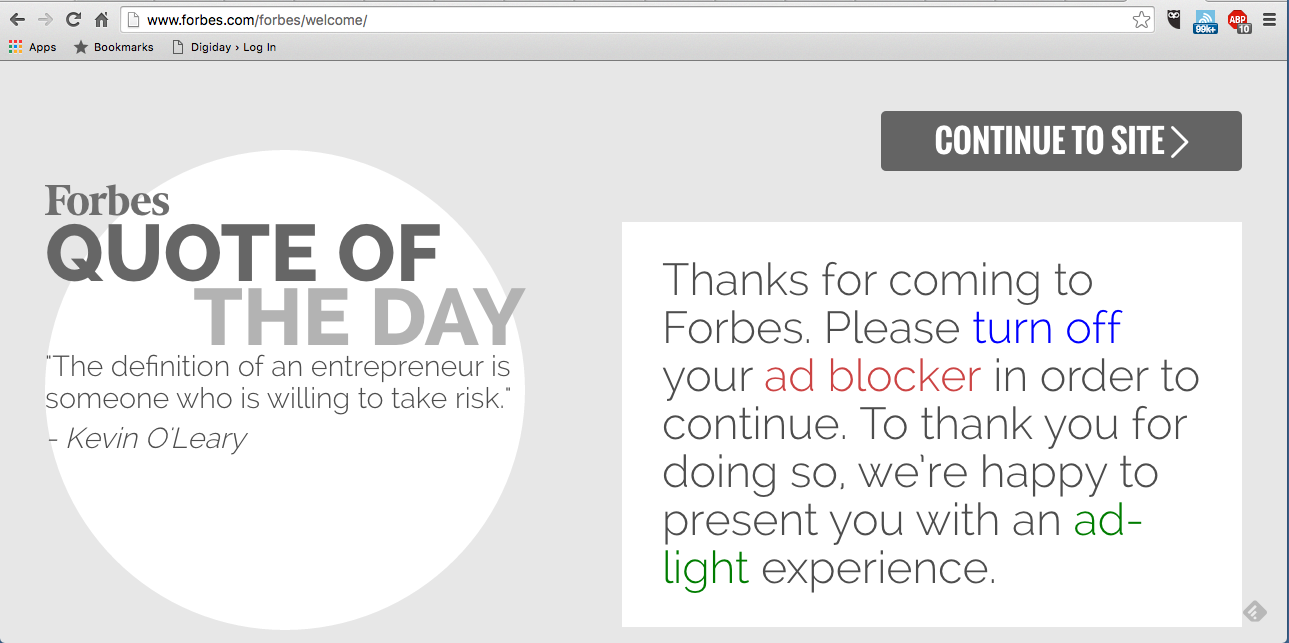Tough sell: Why publisher ‘turn-off-your-ad-blocker’ messages are so polite

For many publishers, ad blocking is outright theft — and they’re mad about it.
But when it comes to explaining to ad-block software users the bargain of free content (it’s free because it comes with ads), they typically tip-toe around the issue, relying, in essence, on “pretty please turn off that ad blocker, if you don’t mind” rather than something more, well, direct.
“Lots of anti-ad-blocking pop-ups read more like a publisher acknowledging defeat than anything persuasive,” said Matt Paddock, general manager at agency Grow. “I’d like to see publishers go further and show a totally honest message that says, ‘While we’re finding other ways to make money, we need to ask for some of yours.’”
To be fair, the politeness has a reason. Many publishers don’t want to lose comScore audience credit or subsequent traffic from shares in social media. But even when publishers take a hard-line stance of denying stories to those with ad blockers, they’re awfully understanding to the point where ad blocking becomes just one big misunderstanding.
Take Wired. When an ad-blocking visitor lands there, the tech publisher is understanding, almost apologizing for the rest of the Internet for driving the user to take the drastic step of downloading an ad blocker, damning all publishers because of the behavior of the worst.

Now, the cynic would say the publisher doth protest just plenty. After all, publishers have for years larded their pages with all manner of tracking pixels, pop-ups, pop-unders, floating ads, autoplay video and other monetizeable atrocities — all in the hope of scoring incremental revenue. One top publisher recently confessed to turning the pop-unders on blast at the end of the quarter to make numbers — a practice that only ended when major browsers blocked the tactics.
Ad position: web_incontent_pos1
It should come as no surprise, then, that publishers are opting for language that carries with it a hint of contrition, as if they are offering a non-apology apology that absolves themselves of any specific wrongdoing while acknowledging wrong was done.
Then there is the always popular guilt trip. Make clear that this isn’t about load time, intrusion or privacy — no, ad blocking is declaring war on journalism itself — and by extension democracy.

The New York Times scrambles for even higher ground, taking a philosophical take on ad blocking that will resonate with many hard-hit publishers, if not actual ethicists.
Ad position: web_incontent_pos2
This is new for the Times, I believe pic.twitter.com/tmJNWboYUx
— Jeremy Barr (@jeremymbarr) March 7, 2016
Of course, not all users will be swayed by appealing to their better sides. At that point, publishers often simply look to bargain with ad blockers, in effect promising from now on — honest! — they’ll behave.

Maybe this is best. It treats users as grownups, has a clear message and offers some kind of compromise, even if it’s vague as to what “ad-light” entails.
“Anything overly cute, clever or snarky is likely to make people angry, since they’re already being slapped on the wrist for blocking ads,” said Deacon Webster, chief creative officer of agency Walrus.
More in Media

NewFronts Briefing: Samsung, Condé Nast, Roku focus presentations on new ad formats and category-specific inventory
Day two of IAB’s NewFronts featured presentations from Samsung, Condé Nast and Roku, highlighting new partnerships, ad formats and inventory, as well as new AI capabilities.

The Athletic to raise ad prices as it paces to hit 3 million newsletter subscribers
The New York Times’ sports site The Athletic is about to hit 3 million total newsletter subscribers. It plans to raise ad prices as as a result of this nearly 20% year over year increase.

NewFronts Briefing: Google, Vizio and news publishers pitch marketers with new ad offerings and range of content categories
Day one of the 2024 IAB NewFronts featured presentations from Google and Vizio, as well as a spotlight on news publishers.
Ad position: web_bfu